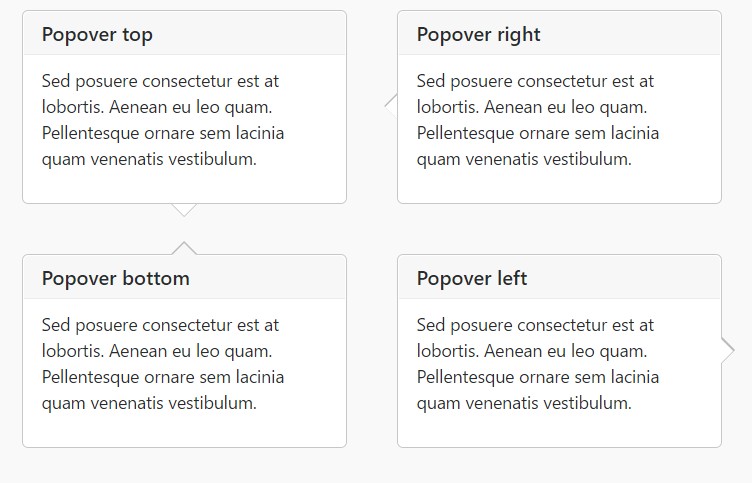Bootstrap Popover Options
Overview
The versions
Bootstrap belongs to the highly handy and totally free open-source platforms to develop web sites. The current version of the Bootstrap platform is named the Bootstrap 4. The system is at the moment in the alpha-testing stage however is available to internet designers throughout the world. You are able to also develop and suggest adjustments to the Bootstrap 4 before its final version is released.
Application of the Bootstrap 4
With Bootstrap 4 you are able to develop your website now much faster than ever before. It is comparatively very simpler to apply Bootstrap to establish your website than various other platforms. By having the integration of HTML, CSS, and JS framework it is among the most popular systems for website growth.
Some components and techniques in Bootstrap 4
A couple of the most recommended capabilities of the Bootstrap 4 include:
• An improved grid structure that helps the user to obtain mobile device responsive web sites along with a fair amount of easiness.
• Several utility instruction sets have been featured in the Bootstrap 4 to help with uncomplicated learning for new users in the field of online development.
Aspects to keep in mind
Step 2: Rewrite your article by highlighting words and phrases.
Together with the introduction of the brand new Bootstrap 4, the connections to the older version, Bootstrap 3 have not been absolutely renounced. The programmers have guaranteed that the Bootstrap 3 does get frequent upgrade and problem resolve in addition to improvements. It will be performed even after the end produce of the Bootstrap 4. Bootstrap 3 have not been fully cut off. The developers have ensured that the Bootstrap 3 does get regular improve and bug fixes along with improvements.
Contrasts about Bootstrap 4 and Bootstrap 3
• The service for many different web browsers including managing systems has been incorporated in the Bootstrap 4
• The general scale of the font is improved for pleasant observing and web site construction experience
• The renaming of a variety of components has been completed to ensure a speedier and much more dependable web development method
• Along with brand new customizations, it is feasible to generate a more interactive web site with very little efforts
Bootstrap Popover Container
And promptly let all of us come to the primary topic.
In case you like to provide special supporting information on your internet site you can certainly work with popovers - just incorporate small overlay content.
Effective ways to apply the popover plugin:
- Bootstrap Popover Form depend upon the Third party library Tether for setting up. You must absolutely include tether.min.js before bootstrap.js in order for popovers to operate!
- Popovers demand the tooltip plugin being a dependency .
- Popovers are opt-in for performance reasons, so that you must initialize them yourself.
- Zero-length
titlecontent- Specify
container:'body'- Generating popovers on hidden components will definitely just not act.
- Popovers for
. disableddisabledwhite-space: nowrap;<a>Did you understood? Excellent, let's discover ways in which they operate using some cases. ( recommended reading)
You will need to provide tether.min.js prior to bootstrap.js needed for popovers to do the job!
Example: Set up popovers everywhere
One idea to activate whole popovers on a web page would definitely be to pick them by their
data-toggle$(function ()
$('[data-toggle="popover"]').popover()
)As an example: Utilizing the container opportunity
If you possess some designs on a parent element which interfere with a popover, you'll prefer to point out a custom
container$(function ()
$('.example-popover').popover(
container: 'body'
)
)Static popover
Four possibilities are easily available: high point, right-handed, bottom, and left lined up.
Live demo

<button type="button" class="btn btn-lg btn-danger" data-toggle="popover" title="Popover title" data-content="And here's some amazing content. It's very engaging. Right?">Click to toggle popover</button>Four courses

<button type="button" class="btn btn-secondary" data-container="body" data-toggle="popover" data-placement="top" data-content="Vivamus sagittis lacus vel augue laoreet rutrum faucibus.">
Popover on top
</button>
<button type="button" class="btn btn-secondary" data-container="body" data-toggle="popover" data-placement="right" data-content="Vivamus sagittis lacus vel augue laoreet rutrum faucibus.">
Popover on right
</button>
<button type="button" class="btn btn-secondary" data-container="body" data-toggle="popover" data-placement="bottom" data-content="Vivamus
sagittis lacus vel augue laoreet rutrum faucibus.">
Popover on bottom
</button>
<button type="button" class="btn btn-secondary" data-container="body" data-toggle="popover" data-placement="left" data-content="Vivamus sagittis lacus vel augue laoreet rutrum faucibus.">
Popover on left
</button>Dismiss on following click
Make use of the
focusCertain markup expected for dismiss-on-next-click
For appropriate cross-browser plus cross-platform behaviour, you will need to work with the
<a><button>tabindex
<a tabindex="0" class="btn btn-lg btn-danger" role="button" data-toggle="popover" data-trigger="focus" title="Dismissible popover" data-content="And here's some amazing content. It's very engaging. Right?">Dismissible popover</a>$('.popover-dismiss').popover(
trigger: 'focus'
)Treatment
Prepare popovers with JavaScript
$('#example').popover(options)Possibilities
Options may be successfully pass using information attributes or else JavaScript. For information attributes, attach the option name to
data-data-animation=""
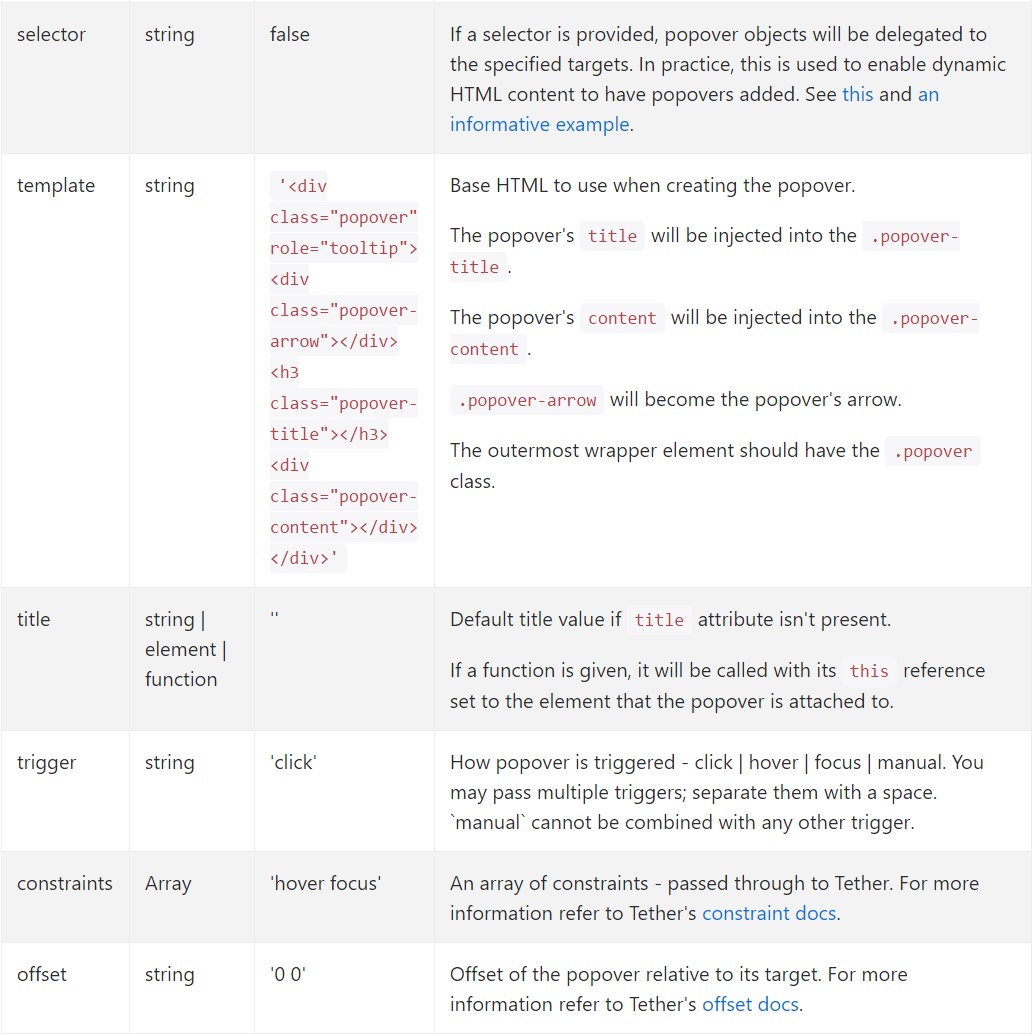
Data attributes for different popovers
Selections for specific popovers have the ability to additionally be defined via the application of data attributes, as illustrated above.
Solutions
$().popover(options)
Initializes popovers to the element variety.
.popover('show')
Shows an element's popover. Go back to the caller right before the popover has really been displayed (i.e. before the shown.bs.popover
event takes place). This is considered a "manual" triggering of the popover. Popovers whose both the title and content are zero-length are never featured.
$('#element').popover('show')
.popover('hide')
Hides an element's popover. Returns to the user before the popover has actually been covered (i.e. before the hidden.bs.popover
activity happens). This is regarded a "manual" triggering of the popover.
$('#element').popover('hide')
.popover('toggle')
Activate an element's popover. Comes back to the user before the popover has truly been revealed or disguised (i.e. before the shown.bs.popover
or hidden.bs.popover
event happens). This is thought of a "manual" triggering of the popover.
$('#element').popover('toggle')
.popover('dispose')
Disguise and wipes out an element's popover. Popovers which apply delegation (which are established working with the selector option) can not really be personally wiped out on descendant trigger features.
$('#element').popover('dispose')
Events

$('#myPopover').on('hidden.bs.popover', function ()
// do something…
)
Check out some video information regarding Bootstrap popovers
Linked topics:
Bootstrap popovers formal information
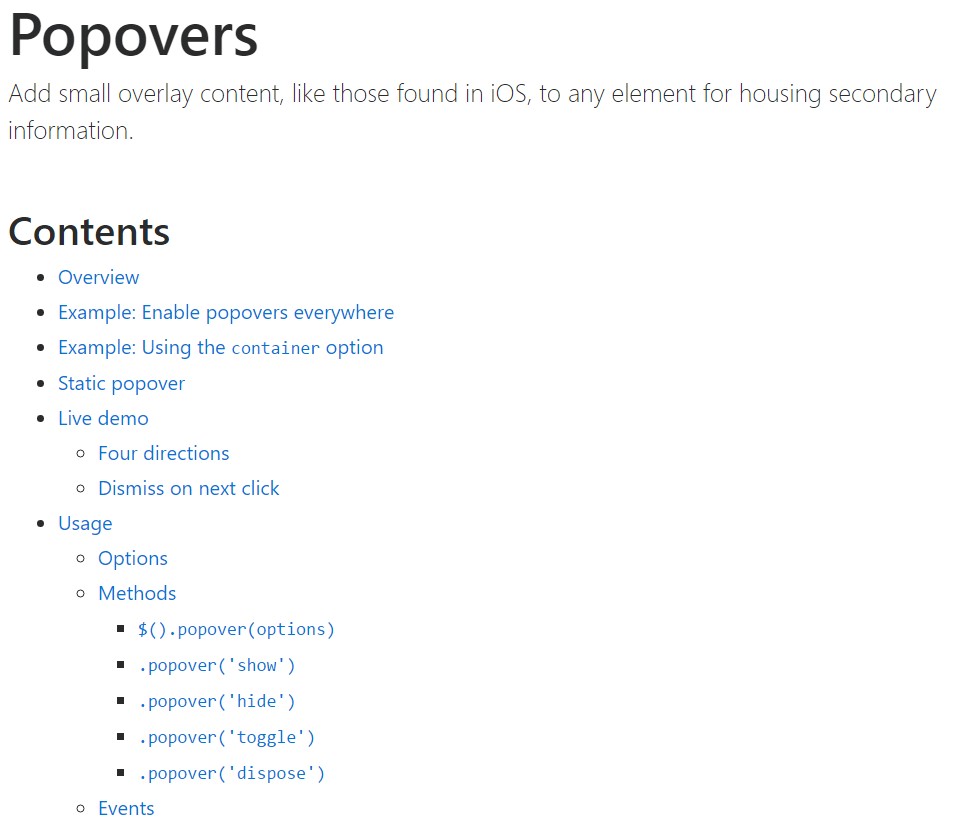
Bootstrap popovers information
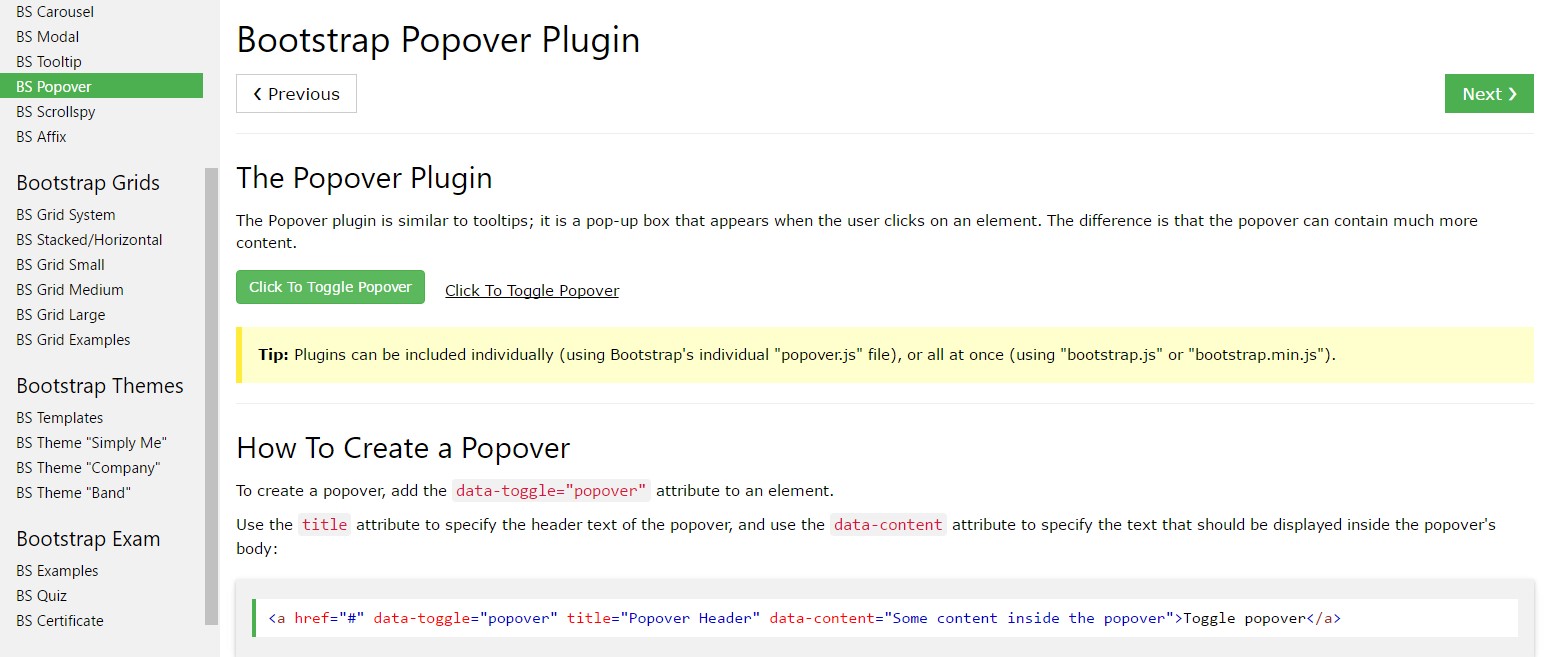
Bootstrap Popover trouble
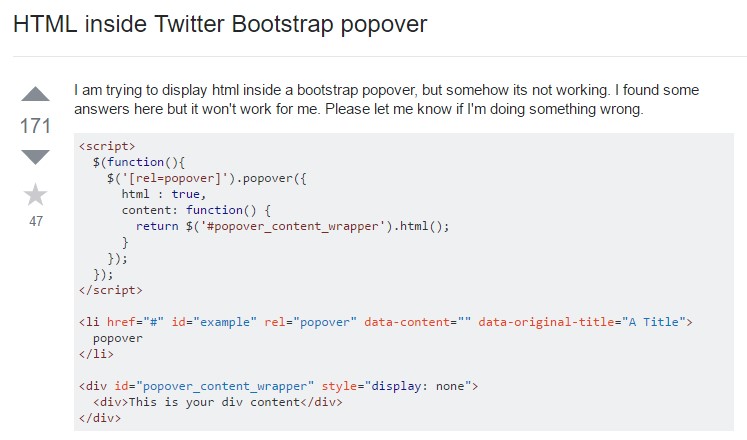
$().popover(options)
Initializes popovers to the element variety.
$().popover(options).popover('show')
Shows an element's popover. Go back to the caller right before the popover has really been displayed (i.e. before the .popover('show')shown.bs.popover$('#element').popover('show').popover('hide')
Hides an element's popover. Returns to the user before the popover has actually been covered (i.e. before the .popover('hide')hidden.bs.popover$('#element').popover('hide').popover('toggle')
Activate an element's popover. Comes back to the user before the popover has truly been revealed or disguised (i.e. before the .popover('toggle')shown.bs.popoverhidden.bs.popover$('#element').popover('toggle').popover('dispose')
Disguise and wipes out an element's popover. Popovers which apply delegation (which are established working with the selector option) can not really be personally wiped out on descendant trigger features.
.popover('dispose')$('#element').popover('dispose')Events

$('#myPopover').on('hidden.bs.popover', function ()
// do something…
)Check out some video information regarding Bootstrap popovers
Linked topics:
Bootstrap popovers formal information

Bootstrap popovers information

Bootstrap Popover trouble

